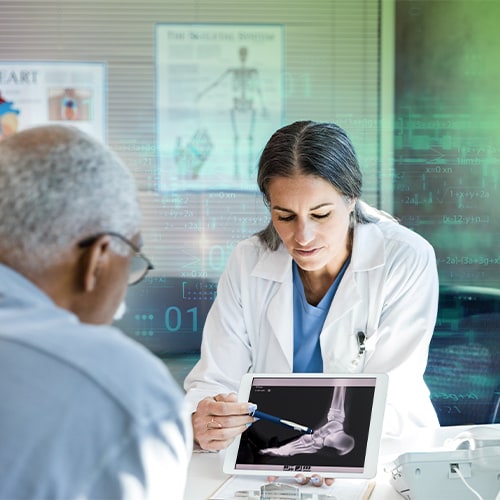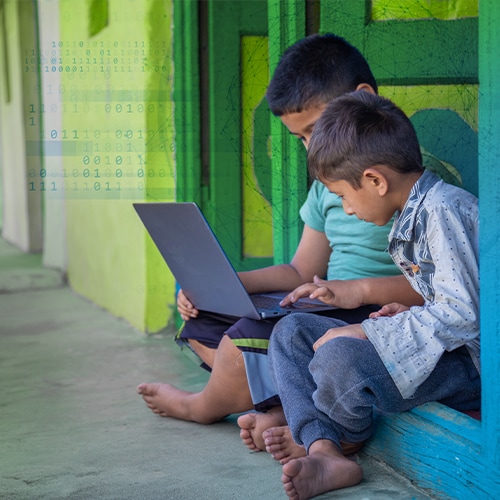Deloitte AI Institute
Toward humanity’s brightest future with Generative AI
Benefits to society from artificial intelligence
View the report
This Fragment is the AI Institute Sidebar
This text and the space it occupies will not be visible in the following environments: "View as published", "Preview", "Live"
We are at a pivotal moment in the history of human invention
For years, the confluence of technologies that power the modern world, like analytics and AI, have been changing and challenging how the world works and societies function. The emergence of GenAI is a significant leap forward. Many of us are energized by the opportunity to be on the ground floor of shaping AI and the future. We are seeing GenAI use cases that drive process efficiency, improve automation, and enhance how humans and machines work together. Yet, these applications only scratch the surface of GenAI’s potential for social good. We should be actively weighing the societal implications of GenAI implementation, particularly as it relates to the future of work, equity and diversity in talent, and promoting trust in technology.
If our attention at this inflection point is narrowly focused on business benefit, we may miss the broader potential impact of GenAI on people and society at large. We have an opportunity to lead, and it begins with an appreciation of GenAI and how it can transform the world for the better.

A grand vision for Generative AI and society
GenAI is acclaimed for its capacity to retrieve and assemble information in a way that appears to be human-created. Text, images, sounds, even 3D models can be conjured with a prompt and without much technical knowledge of how it functions. To this point, much of the experimentation in using GenAI has focused on automation that reduces costs and improves efficiency. Use cases such as call centers, rapid content creation for marketing and engagement, and the ability to reduce manual and time-consuming tasks can deliver value for organizations.
These kinds of applications, however, are the low-hanging fruit of AI deployment, which have been targeted for years with more traditional AI models. With GenAI, we are not simply contending with another business tool. The stunning potential is bigger than that, and with it, we can affect positive impact in people’s lives for generations to come.

Combining the power of human collaboration with technology
Here are two examples demonstrating how we should be thinking of GenAI as a tool for the amplification of human potential. An essential catalyst to reach that potential is trust.
Scenario one:
Imagine an elderly relative who develops a life-threatening disease. Traditionally, doctors might conduct a variety of tests, use their expertise to recommend a treatment, and hope it works. If it does not, the next treatment is tried. In a pre-AI environment, finding the right health solution generally hinges on the physician’s knowledge and trial and error. With GenAI, doctors could:
- Quickly and thoroughly explore vast databases of existing treatments and medical insights, helping to find options that may otherwise remain hidden in the data.
- Access all relevant medical studies and pharma trials, with the insights summarized in an easily digestible format.
- Model a pharmaceutical treatment precisely tailored to the patient’s genome.
These kinds of applications can enable doctors to make better treatment decisions, faster.

Scenario two:
Imagine a young person in a rural area who lacks the opportunity to attend school. With only an internet connection, GenAI could help them:
- Access lessons and activities from teachers across the world, irrespective of language.
- Translate educational content into their native dialect, with GenAI helping to condense and explain new material
We can even envision GenAI assistants that help educators expand capacity and reach more curious minds. When students have commensurate opportunities to learn, no matter who or where they are, the barriers to education diminish.

Navigating trustworthy technology
Risk management has been an enterprise priority for decades, and in recent years, the volume and variety of technologies creating risk have only multiplied.
Just as organizations and societies were getting their arms around the risks traditional AI can present, along came GenAI. There is no shortage of forecasts pointing out known and potential GenAI risks, from the threat of misinformation at scale to latent biases shaping decision making to even more existential problems. We are also beginning to see how the challenge with GenAI is not erasing risk, but balancing the benefits against risks in a way that generates trust.
Leaders of purpose-driven organizations already understand that their decisions directly impact society in the short- and longer-terms. How we prepare ourselves, our organizations, and our societies to use GenAI in a responsible way will influence trust in the technology itself, and by extension, the brightest futures we hope to see come to fruition. It starts with a human-centric vision. If we reject a machine-centric vision and maintain an allegiance to humanity first, we see that a priority for GenAI use is equity in value.
Boards have an important role to play in the future of AI
Board members are positioned to shape the longer-term vision for GenAI, with a focus on sustainable value and trustworthy and responsible application. They can, and should, ask probing questions about the impact on the organization and society and set strategic priorities to navigate those impacts. These activities inform model governance, including roles and responsibilities, post-deployment GenAI management, and legal and compliance matters.
Boards and executives working together can also probe how to ensure people, both in the workforce and elsewhere, have the technical capabilities and knowledge to keep pace with and use AI innovation. We need to support more people in understanding, using, and analyzing GenAI, optimizing the full potential of their skill sets such that they are equipped to join the conversation on how we create tomorrow for the benefit of all. Enterprises and their leaders have an evident role to play.

History is watching. Now is the time to secure a future in which AI is used for social good
Today, we look back on our predecessors and try to understand what their world looked like and how and why they made the decisions they did. We look at the industrial era and try to fathom how child labor, unchecked pollution, and unsafe work environments were ever tolerated. There are so many examples where, with hindsight, we struggle to grasp what our ancestors were thinking.
Our descendants will wonder the same about us. They will perhaps ask; did we make the best decisions in the early days of GenAI?
As leaders, we set the tone. By infusing trust, diversity, and ethics in all our decision-making, we build the stage for GenAI to be used for the benefit of all and in the interest of the brightest futures for the next generation.
It is up to us to get this right.
